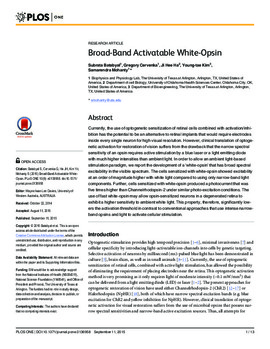| dc.contributor.author | Subrata Batabyal | |
| dc.contributor.author | Gregory Cervenka | |
| dc.contributor.author | Ji Hee Ha | |
| dc.contributor.author | Young-tae Kim | |
| dc.contributor.author | Samarendra Mohanty | |
| dc.date.accessioned | 2017-03-05T22:55:10Z | |
| dc.date.available | 2017-03-05T22:55:10Z | |
| dc.date.issued | 2015-09-11 | |
| dc.identifier.citation | Batabyal S, Cervenka G, Ha JH, Kim Y-t, Mohanty S (2015) Broad-Band Activatable White-Opsin. PLoS ONE 10(9): e0136958. doi:10.1371/journal.pone.0136958 | en_US |
| dc.identifier.uri | https://hdl.handle.net/11244/49270 | |
| dc.description | The authors would like to thank C. Cote and K. Dhakal (UTA) for help during initiation of the project. SM would like to thank K. Deisseroth (Stanford University) for ChR2 and C1V1 plasmids, and J. Lin (UCSD) for the ReaChR construct. | en_US |
| dc.description | | en_US |
| dc.description.abstract | Currently, the use of optogenetic sensitization of retinal cells combined with activation/inhibition has the potential to be an alternative to retinal implants that would require electrodes inside every single neuron for high visual resolution. However, clinical translation of optogenetic activation for restoration of vision suffers from the drawback that the narrow spectral sensitivity of an opsin requires active stimulation by a blue laser or a light emitting diode with much higher intensities than ambient light. In order to allow an ambient light-based stimulation paradigm, we report the development of a ‘white-opsin’ that has broad spectral excitability in the visible spectrum. The cells sensitized with white-opsin showed excitability at an order of magnitude higher with white light compared to using only narrow-band light components. Further, cells sensitized with white-opsin produced a photocurrent that was five times higher than Channelrhodopsin-2 under similar photo-excitation conditions. The use of fast white-opsin may allow opsin-sensitized neurons in a degenerated retina to exhibit a higher sensitivity to ambient white light. This property, therefore, significantly lowers the activation threshold in contrast to conventional approaches that use intense narrow-band opsins and light to activate cellular stimulation. | en_US |
| dc.language.iso | en_US | en_US |
| dc.publisher | PLos One | |
| dc.relation.ispartofseries | PLoS ONE 10(9): e0136958 | |
| dc.relation.uri | http://www.plosone.org/article/info%3Adoi%2F10.1371%2Fjournal.pone.0136958 | |
| dc.rights | Attribution 3.0 United States | |
| dc.rights.uri | https://creativecommons.org/licenses/by/3.0/us/ | |
| dc.subject | Light,White light,Optogenetics,Functional electrical stimulation,Fluorescence microscopy,Visible light,Fluorescence imaging,Light pulses | en_US |
| dc.title | Broad-Band Activatable White-Opsin | en_US |
| dc.type | Research Article | en_US |
| dc.description.peerreview | Yes | en_US |
| dc.description.peerreviewnotes | http://www.plosone.org/static/editorial#peer | en_US |
| dc.identifier.doi | 10.1371/journal.pone.0136958 | en_US |
| dc.rights.requestable | false | en_US |

